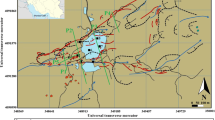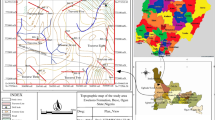Abstract
The study focuses on the application of electrical resistivity methods as a guide for a detailed geotechnical investigation due to the inhomogeneity of the soil materials cum inability of the drilling beyond 38 m from the three initially drilled geotechnical boreholes which did not allow for proper foundation decisions and thus necessitated the research. Two-dimensional (2D) electrical resistivity data were acquired using the Wenner array along ten (10) traverses of about 500 m long, and forty-four (44) vertical electrical sounding (VES) data were acquired along the various traverses using the Schlumberger array with a maximum spread of 620 m. The VES data were interpreted using partial curve matching technique and one-dimensional (1D) computer iteration using WinRESIST software. The 2D dataset were processed using DIPROWin software. The inversion of the 2D resistivity data was constraint by the VES results and available borehole data. The results of the interpretation of the electrical resistivity data reveal that the lithological units underlying the study area compose of clay/peat, clayey sand, sandy clay, and sand. The results of the interpretation of the electrical resistivity data guided by the range of resistivity (ρ) values and knowledge of the geology of the area reveal that the lithological units underlying the study area are composed of peat (ρ < 10 Ωm), clay (10 > ρ < 100 Ωm), clayey sand (100 > ρ < 200 Ωm), sandy clay (200 > ρ < 300 Ωm), and sand (ρ > 300 Ωm). The various layers are intercalated with each other, and thickness values vary from one location to another up to a maximum depth of 70 m. The VES results show that the clayey material underlies the sand-filled topsoil and there are indications of competent sand layers at depth beneath these clayey layers in the study area. The 2D pseudosections reflect that the different lithological units are intercalated with varying thicknesses across the study area. Thus, the study reveals that the subsoil within the study area is quite inhomogeneous and great care and expertise is required for developing the site. Anonymously low-resistivity areas delineated along each of the traverses are locations recommended for targeted geotechnical investigation prior to construction.







Similar content being viewed by others

References
Adepelumi AA, Olorunfemi MO, Faletiba DE, Bayowa OG (2009) Structural mapping of coastal plain sands using engineering geophysical technique: Lagos Nigeria Case Study. Nat Sci 1:2–9
Adepelumi AA, Olorunfemi MO (2000) Engineering geological and geophysical investigation of the reclaimed Lekki Peninsula, Lagos. South West Nigeria Bull Eng Geol Environ 58:125–132
Akintorinwa OJ, Adelusi FA (2009) Integration of geophysical and geotechnical investigations for a proposed lecture room complex at the Federal University of Technology, Akure, SW, Nigeria. Ozean J Appl Sci 2(3):241–254
Akintorinwa OJ, Adesoji JI (2009) Application of geophysical and geotechnical investigations in engineering site evaluation. Int J Phys Sci 4(8):443–454
Adeoti L, Kehinde I, Adegbola RB, Sovi ST (2009) Foundation investigation using electrical resistivity method: a case study of Iponri, Lagos State, Nigeria. J Eng Res 14(1):50–57
Adeyemi PA (1972) Sedimentology of Lagos Lagoon. B.Sc. Thesis, Obafemi Awolowo University, Ife-Ife, Osun State, , Nigeria
Adeyemo IA, Omosuyi OG (2012) Hydrogeologic, electrical and electromagnetic measurements for geotechnical characterization of foundation beds at Afunbiowo, near Akure, Southwestern Nigeria. Ind J Sci Tech 5(2):0974–6846
Ayolabi EA, Folorunso AF, Oloruntola MO (2010) Constraining causes of structural failure using electrical resistivity tomography (ERT): a case study of Lagos, Southwestern, Nigeria. J Geophys Min Wealth 156(210):7–18
Barker RD (1997) Electrical imaging and its application in engineering investigations. In McCann DM, Eddleston M, Fenning P J and Reeves G M (ed) Modern geophysics in engineering (Geological Society Special Publication 12) pp 37–43
Bhattacharya PK, Patra HP (1968) Direct current geoelectric sounding: principles and interpretation. Elsevier, Amsterdam, p. 135
Durotoye AB (1975) Quaternary sediments in Nigeria. In: Kogbe CA (ed) Geology of Nigeria. Elizabeth Press, Lagos, pp. 431–451
Fatoba JO, Salami BM, Adesida A (2013) Structural failure investigation using electrical resistivity method: a case study of Amafor Ihuokpala, Enugu, Southeastern Nigeria. J Geo Min Res 5(8):208–215
Fatoba JO, Alo JO, Fakeye AA (2010) Geoelectric imaging for foundation failure investigation at Olabisi Onabanjo University Minicampus, Ago-Iwoye, Southwestern Nigeria. J Appl Sci Res 6(12):2192–2198
Halstead LB (1971) The shoreline of Lake Kainji, a preliminary survey. J Min Geo 6:1–22
Jones GPA (1960) Sedimentary study of the Ngalda gravels, Bauchi province, N E Nigeria. Record of Geological survey, Nigeria, pp. 29–40
Jones HA, Hockey ED (1964) The geology of part of southwestern Nigeria. Geol Survey Nigeria Bull 31:1–101
Loke M. H. (2004): Tutorial: 2-D and 3-D electrical imaging surveys. 2004 revised edition. www.geometrics.com
Longe EO, Malomo S, Olorunniwo MA (1987) Hydrogeology of Lagos Metropolis. J African Earth Sci 6:163–174
McDowell PW, Barker RD, Butcher AP, Culshaw MG, Jackson PD, McCann DM, Skipp BO, Mattew SL, Arthur JCR (2002) Geophysics in engineering investigations. Geol Soc London, Eng Geol Special Pub 91:260
Neil A, Neil C, Rick H, Phil S (2008) Geophysical methods commonly employed for geotechnical site characterization. Transportation Research Circular, Number E-C130: 44
Olorunfemi MO, Meshida EA (1987) Engineering geophysics and its application in engineering site investigations (case study from Ife-Ife area). Nigerian Eng 22:57–66
Olorunfemi MO, Idornigie AI, Coker AT, Babadiya GE (2004) On the application of the electrical resistivity method in foundation failure investigation—a case study. Glob J Geol Sci 2(1):139–151
Omoloyole NA, Oladapo MI, Adeoye OO (2008) Engineering geophysical study of Adagbakuja Newtown Development, Southwestern Nigeria. Medwell Online J Earth Sci 2(2):55–63
Orellana E, Mooney HM (1966) Master tables and curves for vertical electrical soundings over layered structures. Interciencia, Madrid
Pugh JC (1954) A classification of the Nigerian coastline. J West African Sci Assoc 1:3–22
Salami BM, Faletiba DE, Fatoba JO, Ajala MO (2012) Integrated geophysical and geotechnical investigation of a bridge site: a case study of a swamp/creek environment in South East Lagos, Nigeria. IFE J Sci 14(1):75–81
Soupios PM, Georgakopoulos P, Papadopoulos N, Saltas V, Andreadakis A, Vallainatos F, Sarris A, Makris JP (2007) Use of engineering geophysics to Investigate a site for a building foundation. J Geophy Eng 4:94–103
Vander Velpen BPA, Sporry RJ (1993) RESIST—a computer program to process resistivity sounding data on PC compatibles. Comput Geosci 19(5):691–703
Yi MJ, Kim JH, Chung SH (2003) Enhancing the resolving power of least-squares inversion with active constraint balancing. Geophysics 68:931–941
Acknowledgments
The authors would like to express their gratitude to Pearl Armour Consulting for providing fund for this research work.
Author information
Authors and Affiliations
Corresponding author
Rights and permissions
About this article
Cite this article
Adeoti, L., Ojo, A.O., Adegbola, R.B. et al. Geoelectric assessment as an aid to geotechnical investigation at a proposed residential development site in Ilubirin, Lagos, Southwestern Nigeria. Arab J Geosci 9, 338 (2016). https://doi.org/10.1007/s12517-016-2334-9
Received:
Accepted:
Published:
DOI: https://doi.org/10.1007/s12517-016-2334-9



